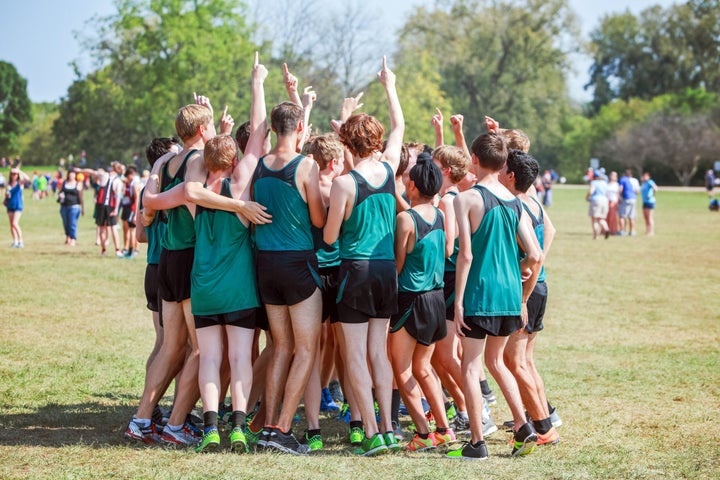Jason found running at an early age, it was his way to stand out on the soccer field, his skill allowed him to capture medals on field days and countless school races. As he entered High School he naturally found Cross Country and Track. He’s a consistent contributor to his team. He’s the #2 man on the cross-country team and can reliably put points on the board to help his team advance to State year after year. He’s a great student in the classroom and an endearing personality at home.
Like many athletes his age, however, he can often find himself working through difficult feelings about “not having what I want,” emotions that often turn into “I feel like no matter how hard I work, I’m not getting better,” and after a particularly tough race it can get as bad as “why try.”
Jason’s feelings of inadequacy can flair when he logs on to social media and begins to compare himself against friends, competitors at other schools, and professional runners. He gives these people space in his brain; the recent grad heading to Stanford or the local prep star rival getting covered by a big media outlet previewing the upcoming season.
Jason can be found downloading the rankings to see where he sits compared to others. He sees he’s slipped a few places from last year. He’ll scroll through the comments on a post and see hundreds of accolades and look at his own post about his recent run and wonder why his work hasn’t garnered the same enthusiasm and appeal. How will he ever get the recognition and love of his peers?
Even with his success, these comparisons create an ambivalence towards racing and training. They follow Jason to the start line, dragging him down like a giant boat anchor. He’s happy to contribute to his team and to be a Top 20 kid in his league, but he’ll just as quickly say, “But I was Top 15 last year!”—ignoring that he’s gone from the 5th scoring athlete to the 2nd scoring athlete on his team and shaved off over at 30 seconds from his times last year. He chooses to focus on his perceived shortcomings. It goes so far to affect his performance, as Jason finds himself letting up in a race when he doesn’t see that it will be a new PR.

Keeping Up with the Highlight Reel
Jason isn’t an actual young runner, but he’s not fiction either: he’s a compilation of approximately 15 different athletes I’ve worked with as a coach. Young athletes are finding it harder to have a strong personal concept as the information they take in often leaves them comparing against a mark that is largely unachievable.
Comparison to others is the default for young athletes, and nothing new. In some ways, comparison can be helpful and even motivational. The inspiration you get from seeing a crosstown rival out training can amp you up and motivate you to get out the door or push for one more rep. The recognition you receive when you succeed over others can boost your self-esteem.
But social media often creates a skewed image of others. A 2017 study published in Buzzoid reported, “Generally, humans have a tendency towards sharing positive (rather than negative) news about themselves, but this tendency seems to hold particularly for social network site users.”
Comparing real life to these idealized ones can lead to depression, anxiety, and an overwhelming sense of inferiority. As a youth coach or parent, we often have to teach athletes to create a strong, independent self-concept, and move beyond comparing themselves against the highlight reel of their peers online, which inevitably leads to disappointment.
Making comparisons healthy, productive, and authentic requires a shift in thinking from a place of self-deprecation to a view of self-enhancement. Self-improvement occurs when upward comparison drives us to work harder and become better.
Self–enhancement occurs when we identify similarities to others (we went to the same camp this summer), (we’re both on the same club team) or play up differences to someone (he’s not as dedicated in the weight room, this is my advantage!). Our vision of self is eroded, however, when we note differences that feel insurmountable (he’s faster than I’ll ever be). These types of comparisons are neither motivating nor useful in personal growth and advancement.
The Phones Are Here to Stay
Athletes are constantly asked to put down their phones, but what many coaches are coming to understand is that the phone is not a part of the athlete’s social spectrum, its core to their identity. To grow up in this world of social comparison and social media, athletes seek out ways to view and utilize social media as a means to connect where their peers are.
Social Media at it’s best can be a way to drive a stable sense of self, and at it’s worse a motivator to achieve fame and popularity however short-lived. A 2008 study in Future Child observed that the lines between the virtual and real-world are increasingly blurred for youth today. “For today’s youth, media technologies are an important social variable and … physical and virtual worlds are psychologically connected; consequently, the virtual world serves as a playing ground for developmental issues from the physical world,” the researchers pointed out.
How athletes use their social networks is becoming more a part of their social identity—their narrative is no longer easily answered by a simple question of “how was school?” or “how was practice?” Youth athletes now find themselves surrounded by media that will have them asking, “How good is my life compared to yours?” Encouraging and teaching athletes a healthy way to develop themselves as individuals, and furthermore help them develop skills on and off the field is how coaches can help ensure that athletes leave their programs as the best version of themselves.

Moving on from Online Comparisons
How can we move athletes from a place of comparison and move to a place of genuine connection? Here are 5 strategies I’ve found effective as a youth coach.
1 – Engage beyond social media.
Endless scrolling and constant posting encourages athletes to only seek out the best and most flattering news and images of themselves. The reality is most people are just going to scroll by and mindlessly double-tap the screen. Instead, create a world of genuine connection where you are as present with others offline as you pretended you were online. Say to someone’s face the comments you leave on their posts. ‘Dude, you’re so fast’ has so much more significance when you say it to someone in real life.
2 – Make time to connect.
Shorthand and 3-word comments might feel good under a post, but when that’s the depth of your friendship you can be left feeling pretty lonely. Put yourself in a position to be present. Talk about shared experiences, dig down a few layers and get to know your teammates and friends. A deeper connection goes a long way after a tough race. Make time after your next race or event to be away from your phone and connect with the people around you.
3 – Count other’s blessings.
Instead of focusing on where you came up short—try to exercise your motivation muscle and help others see where they succeed. As a peer, showing a teammate or student where they improved not only creates a shift in thinking for you but also can often disrupt someone else’s negativity spiral. This creates an environment where motivating others is the norm; You’ll often find that motivating others and recognizing improvement will also allow you to recognize your own improvements and help you make a big shift!
4 – Be your own meter stick.
Measure against yourself. Internal evaluation requires significant maturity and practice. Comparing to others is a great way to become disappointed, seeking out how you improved will result in a much happier athlete overall. A happy runner compares himself to his last run or training cycle, not to the top of the Strava Leaderboard.
5 – Set attainable, personal goals.
Taking a 45-second jump in your 5K might be where you want to be (and what your rival did last week?). But if you go out seeking only that mark and come up 15 seconds short, you’ll find yourself disappointed with a 30 second PR. Instead, set yourself up to stretch your goals in phases and set minor goals that build towards larger goals. Celebrate every personal improvement, even the small stuff—you’re better than you’ve ever been!


